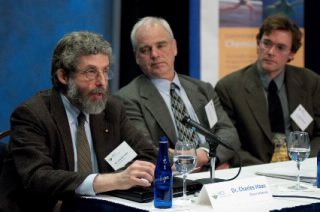FOR IMMEDIATE RELEASE | January 28, 2009
Substantial work ahead for water issues, say scientists at ACS’ Final Report briefing
WASHINGTON, Jan. 27, 2009 — Scientists and engineers will face a host of obstacles over the next decade in providing clean water to millions of people caught up in a water shortage crisis, a panel of scientists and engineers said today at a briefing at the Broadcast Center of the National Press Building on the Final Report on the American Chemical Society’s Global Challenges/Chemistry Solutions.
The American Chemical Society (ACS), the world’s largest scientific society, launched Global Challenges in 2008 as a special series of 12 podcasts and webpages describing how scientists are responding to enormous challenges facing 21st Century society. The reality today, said Marc Edwards, Ph.D., a panelist from Virginia Tech University, is that the existing plumbing infrastructure is inadequate, and scientists have insufficient knowledge about how to overcome the challenges of providing safe water to people around the world.
Edwards, a noted authority whom Time magazine termed “the Plumbing Professor” and named as one of the top innovators of 2004, also detailed how a change in disinfectant from chlorine to chloramine caused leaching of lead into drinking water. A new study by Edwards and colleagues from Virginia Tech University and Children’s National Medical Center concludes that hundreds of children in Washington, D.C. were introduced to high levels of lead from the city’s drinking water. The study will be published in Environmental Science & Technology, one of ACS’ 34 peer-reviewed scientific journals.
“The predictions for the levels of lead in water in D.C. from 2001 to 2003, based on prior scientific research, were very significant and disturbing,” Edwards said. “When the first reports came out finding that there was no detectable harm done, it defied previous scientific understanding. So we did our own study. For the youngest children, those under the age of 1.3 years, you saw substantial increases in blood-lead incidence immediately after switching to chloramine.”
Finding appropriate and sustainable solutions to problems like these, said William Ball, Ph.D., from Johns Hopkins University, demands a sharper focus on water-related science. Ball uses computer science to provide a more intelligent way of gathering environmental data. For the last three years, he has collaborated with environmental engineers, hydrologists, and computer scientists to create the Chesapeake Bay Environmental Observatory (CBEO). The CBEO has added to data that has been developed for decades on Chesapeake Bay.
“I disagree with the assertion that the science is understood but we just lack the political will,” Ball said. “In fact, we’re shy on both fronts, and we need to keep moving forward. The work so far — we’re interpolating past data and analyzing past data — reveals that the Bay is even more complex than many might imagine.”
For instance, hypoxic zones in the Bay — large areas of low oxygen levels where most animals can’t live — are still growing despite an apparent plateau in nutrient loadings. “We don’t fully understand why that is so,” Ball said. “There’s a lot to be learned yet about what locations and causes lead to that phenomenon, for example, whether there are carbon sources coming in from the shallows into the deep that current models and understanding don’t capture.”
Ball urged political action on nutrient reductions, the so-called "low-lying fruit." “But we also have to strategize on what the next fruit to pick could be and even what trees to plant, and that takes a lot of planning,” he said.
Risk is another factor that takes planning, said Charles Haas, Ph.D., from Drexel University, who specializes in keeping America’s water supply safe from terror attacks. “We’ll never be in a risk-free environment in water or in any environmental media,” he said. Terrorism in general, Haas said—and terrorism in water systems especially—is expected to be rare. “So protecting against a rare event is hard, and it’s hard to justify on its own in terms of cost benefit assessments.” Haas suggested an emphasis on approaches with dual benefits — not only against terrorism but also for protection of water systems in everyday life.
For example, the use of sensors to detect potentially toxic substances in water could provide general benefits for safety. Cost-effective, low maintenance sensors are a Holy Grail, Haas said, but difficult to develop. He warned that over-sensitive sensors could be counterproductive.
“We need to guard against false alarms,” Haas said, likening the situation to a smoke detector responding to a lit match. “That wouldn’t be a very good detector in terms of having false alarms. No one has succeeded in developing cheap, low maintenance sensors for water contaminants that could detect low levels of substances and do so with a low probability of a false signal.”
Margaret Cavanaugh, Ph.D., National Science Foundation, served as moderator for the panel. Thomas H. Lane, Ph.D., ACS president, introduced the panel.
At the briefing, ACS issued content from the award-winning Global Challenges project — 30,000 words of text based on input from more than 125 specialists — in an 80-page full-color book. Hard copies of the report are available from the ACS Office of Public Affairs. An easy-to-read digital version can be accessed at http://www.cendigital.org/acsgccs/2009. A webcast of the press briefing can be viewed at www.visualwebcaster.com/american-chemical-society.
The podcasts are available without charge for listening on computers and downloading to portable audio devices at iTunes (requires iTunes software) and other podcasting sites. They also can be accessed on ACS’s Global Challenges website. The site provides audio links and full transcripts of each podcast. Additional resources on each Global Challenges topic also are available, on the site, including information for consumers, students, and educators.
Updates to the original podcast series will be posted throughout 2009, presenting the latest scientific research findings on each of the 12 topics.
###
— John Simpson


